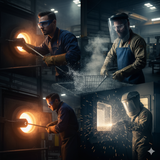Stay Safe, Stay Cool: Your Guide to Hydration and Heat Safety at Work This Summer
OSHA National Emphasis Program on Heat Illness Prevention
Extreme heat poses a significant threat to workers, and The Occupational Safety and Health Administration (OSHA) has taken notice. The OSHA National Emphasis Program on Heat Illness Prevention aims to protect workers from heat-related illnesses through proactive inspections in indoor and outdoor work environments. The program includes triggers for heat-related inspections and emphasizes days with extreme heat risk identified by the National Weather Service.
OSHA requires employers to provide a workplace protected against known hazards, including extreme heat. To meet these requirements, employers can implement engineering, administrative and personal protective measures to address heat-related threats. Control measures may include monitoring employee exposure, training, providing cooling systems and scheduling work during cooler hours. In addition, outdoor workers may benefit from shade, fans, misters, cooling clothing and frequent hydration breaks.
- Establishing clear heat stress prevention plans.
- Ensuring proper hydration for all workers, utilizing solutions like Gatorade.
- Providing the necessary equipment for worker safety and comfort.
- Phase Change Cooling: Such as cooling vests and packs, to help workers maintain a safe body temperature.
- Evaporative Cooling: Including cooling towels, neck wraps, and sleeves, which use water evaporation to provide a cooling effect.
- Absorptive Cooling: Like cooling sweatbands and bandanas, to manage sweat and improve comfort.
- Sun Protection: With items like visors and neck shades to shield from the sun's harmful rays.
- Breathable Workwear: Such as Bisley X-Airflow™ Workwear and Bisley Workwear Essentials T-Shirts, designed to enhance airflow and comfort.
Recent Posts
-
More Than Goggles: The Specialized Eye Protection Needed for High-Heat Industrial Environments
In facilities that process metal at extreme temperatures, eye safety is a complex, multi-layered cha …12th Nov 2025 -
Double Defense: Why Cut and Impact Protection is Critical for Material Handling
In facilities that deal with heavy metal parts, sharp edges, and complex machining, a standard work …11th Nov 2025 -
Beyond the Flame: Why NFPA 2112 FR Apparel is Non-Negotiable
In high-risk industrial settings—from petrochemical plants and utilities to metal processing and hea …7th Nov 2025



